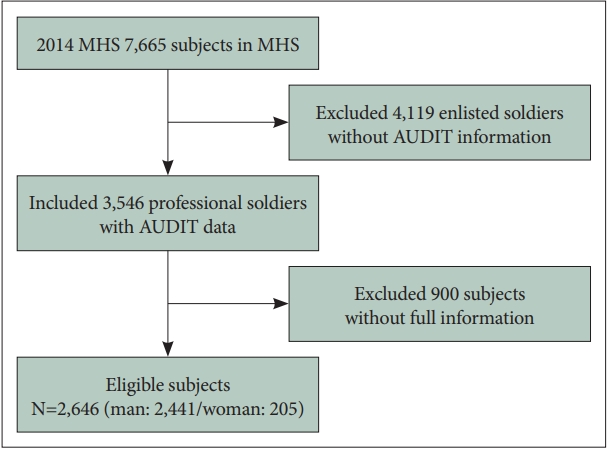1. Anderson P, Baumberg B. Alcohol in Europe-public health perspective: report summary. Drugs: Educ Prev Policy 2006;13:483-488.

2. Sacks JJ, Gonzales KR, Bouchery EE, Tomedi LE, Brewer RD. 2010 national and state costs of excessive alcohol consumption. Am J Prev Med 2015;49:e73-e79.


3. Laramée P, Kusel J, Leonard S, Aubin HJ, François C, Daeppen JB. The economic burden of alcohol dependence in Europe. Alcohol Alcohol 2013;48:259-269.


4. World Health Organization. Global status report on alcohol and health. Geneva: World Health Organization; 2011.
5. World Health Organization. Global status report on alcohol and health 2018. Geneva: World Health Organization; 2018.
9. Mattiko MJ, Olmsted KLR, Brown JM, Bray RM. Alcohol use and negative consequences among active duty military personnel. Addict Behav 2011;36:608-614.


10. Thandi G, Sundin J, Ng-Knight T, Jones M, Hull L, Jones N, et al. Alcohol misuse in the United Kingdom armed forces: a longitudinal study. Drug Alcohol Depend 2015;156:78-83.


11. Hoerster KD, Lehavot K, Simpson T, McFall M, Reiber G, Nelson KM. Health and health behavior differences: U.S. military, veteran, and civilian men. Am J Prev Med 2012;43:483-489.

13. McLaughlin R, Nielsen L, Waller M. An evaluation of the effect of military service on mortality: quantifying the healthy soldier effect. Ann Epidemiol 2008;18:928-936.


15. McKenzie DP, McFarlane AC, Creamer M, Ikin JF, Forbes AB, Kelsall HL, et al. Hazardous or harmful alcohol use in Royal Australian Navy veterans of the 1991 Gulf War: identification of high risk subgroups. Addict Behav 2006;31:1683-1694.


16. Calhoun PS, Elter JR, Jones ER Jr, Kudler H, Straits-Tröster K. Hazardous alcohol use and receipt of risk-reduction counseling among U.S. veterans of the wars in Iraq and Afghanistan. J Clin Psychiatry 2008;69:1686-1693.


17. Blow AJ, Gorman L, Ganoczy D, Kees M, Kashy DA, Valenstein M, et al. Hazardous drinking and family functioning in National Guard veterans and spouses postdeployment. J Fam Psychol 2013;27:303-313.


18. Macmanus D, Dean K, Jones M, Rona RJ, Greenberg N, Hull L, et al. Violent offending by UK military personnel deployed to Iraq and Afghanistan: a data linkage cohort study. Lancet 2013;381:907-917.


19. Booth-Kewley S, Highfill-McRoy RM, Larson GE, Garland CF. Psychosocial predictors of military misconduct. J Nerv Ment Dis 2010;198:91-98.


20. Dworkin ER, Bergman HE, Walton TO, Walker DD, Kaysen DL. Cooccurring post-traumatic stress disorder and alcohol use disorder in US military and veteran populations. Alcohol Res 2018;39:161-169.


21. Ministry of National Defense Republic of Korea. 2014 defense white paper. Seoul: Ministry of National Defense Republic of Korea; 2014.
22. OECD. OECD health statistics 2019: definitions, sources and methods. Paris: OECD; 2019.
23. Radloff LS. The CES-D scale: a self-report depression scale for research in the general population. Appl Psychol Meas 1977;1:385-401.
25. Jang SY, Jang SI, Bae HC, Shin J, Park EC. Precarious employment and new-onset severe depressive symptoms: a population-based prospective study in South Korea. Scand J Work Environ Health 2015;41:329-337.


26. Saunders JB, Aasland OG, Babor TF, de la Fuente JR, Grant M. Development of the alcohol use disorders identification test (AUDIT): WHO collaborative project on early detection of persons with harmful alcohol consumption-II. Addiction 1993;88:791-804.


27. Fiellin DA, Reid MC, O’Connor PG. Screening for alcohol problems in primary care: a systematic review. Arch Intern Med 2000;160:1977-1989.


28. Babor TF, Higgins-Biddle JC, Saunders JB, Monteiro MG, AUDIT. The alcohol use disorders identification test: guidelines for use in primary care. Geneva: World Health Organization; 2001.
32. Lee HK. Epidemiology of alcohol use disorders and alcohol policy. J Korean Neuropsychiatr Assoc 2019;58:152-158.


33. Lee BO, Lee CH, Lee PG, Choi MJ, Namkoong K. Development of Korean version of alcohol use disorders identification test (AUDIT-K): its reliability and validity. J Korean Acad Addict Psychiatry 2000;4:83-92.
34. Frezza M, di Padova C, Pozzato G, Terpin M, Baraona E, Lieber CS. High blood alcohol levels in women. The role of decreased gastric alcohol dehydrogenase activity and first-pass metabolism. N Engl J Med 1990;322:95-99.


35. Baraona E, Abittan CS, Dohmen K, Moretti M, Pozzato G, Chayes ZW, et al. Gender differences in pharmacokinetics of alcohol. Alcohol Clin Exp Res 2001;25:502-507.


39. Fear NT, Iversen A, Meltzer H, Workman L, Hull L, Greenberg N, et al. Patterns of drinking in the UK armed forces. Addiction 2007;102:1749-1759.


40. Browne T, Iversen A, Hull L, Workman L, Barker C, Horn O, et al. How do experiences in Iraq affect alcohol use among male UK armed forces personnel? Occup Environ Med 2008;65:628-633.


41. Henderson A, Langston V, Greenberg N. Alcohol misuse in the Royal Navy. Occup Med (Lond) 2009;59:25-31.


42. Cucciare MA, Sadler AG, Mengeling MA, Torner JC, Curran GM, Han X, et al. Associations between deployment, military rank, and binge drinking in active duty and Reserve/National Guard US servicewomen. Drug Alcohol Depend 2015;153:37-42.


43. Ahern J, Galea S, Hubbard A, Midanik L, Syme SL. “Culture of drinking” and individual problems with alcohol use. Am J Epidemiol 2008;167:1041-1049.


44. Marín G. Expectancies for drinking and excessive drinking among Mexican Americans and non-Hispanic whites. Addict Behav 1996;21:491-507.


45. Kypri K, Langley JD, McGee R, Saunders JB, Williams S. High prevalence, persistent hazardous drinking among New Zealand tertiary students. Alcohol Alcohol 2002;37:457-464.












